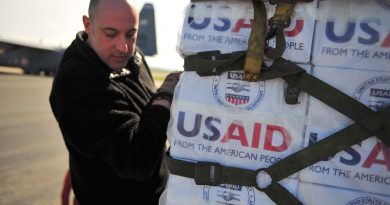Pakistan Receives International Aid After Devastating Floods
Charlotte Sens
Staff Writer
Since mid-June Pakistan has been devastated by floods with an estimated 1,400 dead, and over 30 million people displaced, according to The New York Times. The nation’s Minister of Finance, Miftah Ismail, estimates that there have been around $10 billion in damages caused by the flooding, however, others believe that there could be up to twice that amount and that the damages will only continue to rise, reports Al Jazeera. About one-third of Pakistan has been affected by the floods, with the district of Dadu in Sindh province being among one of the most severely flooded, reports the Associated Press.
Among the billions of dollars in damages caused by the unprecedented flooding is the destruction of about 2 million acres of farmland and 735,000 livestock, according to BBC News. This has raised concerns about a food shortage striking the nation. The Associated Press reports the rising cost of vegetables and other foods in the nation, as Pakistan’s agriculture belt in eastern Punjab and southern Sindh provinces has flooded. So far, United Nations agencies as well as other countries have sent aid to Pakistan, including the United States. According to the Associated Press, altogether about 60 plane loads of aid have been sent to the nation. The U.S. has sent six planes to Pakistan, loaded with food, three of which were sent to the hardest-hit Sindh province. Additionally, the U.S. has organized a humanitarian air bridge to Pakistan that will consist of 20 flights to the nation. The U.S. also plans to distribute cash to those in need.
The severity of the floods in Pakistan has raised alarm bells for the international community, as many experts believe that the floods were exacerbated by climate change. USA Today reports that Pakistan’s former Minister for Climate Change, Malik Amin Aslam, believes that extreme heatwaves in April and May were the precursor to the flooding, as temperatures rose as high as 123 degrees Fahrenheit. This increased the severity of the floods since they were, in large part, caused by monsoon rains. Monsoons are shifts in the direction of winds caused by changes in temperatures on the land and water as the seasons progress. Because the temperatures were so high in April and May, it caused the monsoon rains to come in quicker and have more intense winds and rain. USA Today further stated that Pakistan’s national rainfall in August was over 240 percent higher than average. However, the intense heat Pakistan experienced also led to increased glacier melt from Pakistan’s 7,200 glaciers, reports NPR. The combination of both intense monsoon rains and heightened glacier melt were the key factors behind the unprecedented caliber of the flooding.
United Nations Secretary-General Antonio Guterres visited Pakistan on September 9 and 10 to observe the widespread damage to the nation, stating that he has “seen many humanitarian disasters in the world, but [he] has never seen climate carnage on this scale,” reports Al Jazeera. They also state that Guterres has claimed that “wealthier countries are morally responsible for helping developing countries like Pakistan to recover from disasters like [the floods].” G20 nations cause roughly 80 percent of the Earth’s greenhouse gas emissions, but it is poorer nations like Pakistan, which emits less than 1 percent of global emissions, that are facing the deadly consequences. The unprecedented nature of these floods further demonstrates that the impacts of climate change are no longer a future threat, but a present reality. Pakistan is still reeling from the effects of the flood and, despite receiving support from many states and organizations around the world, it will take a long time for the nation to recover from the damage these floods have wrought.




